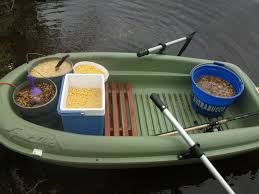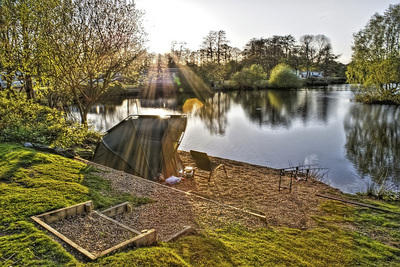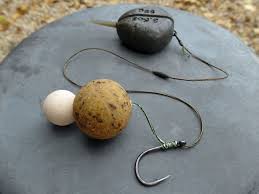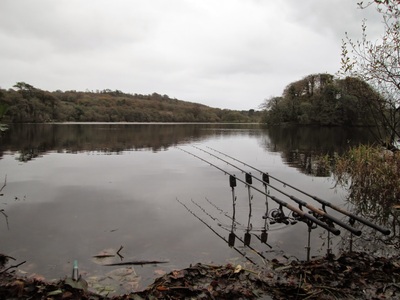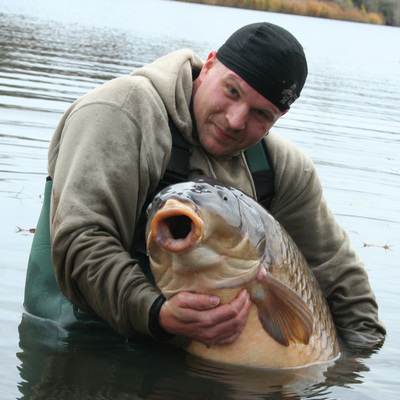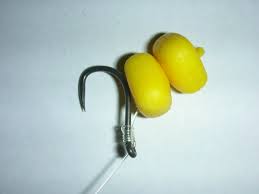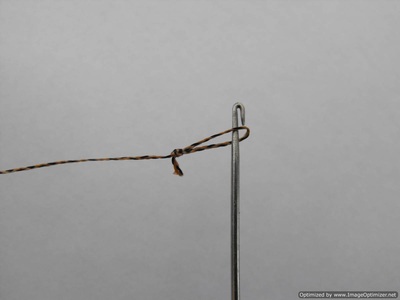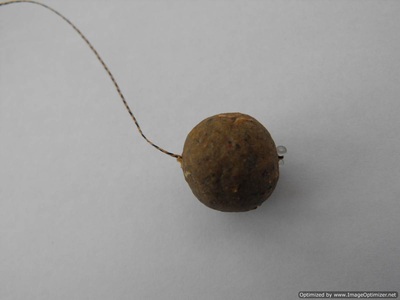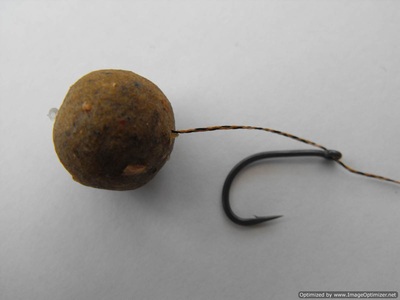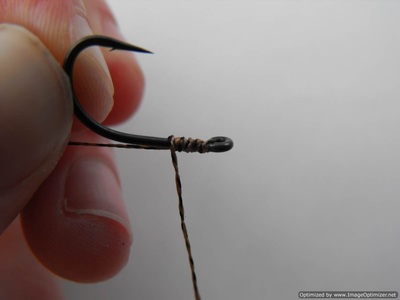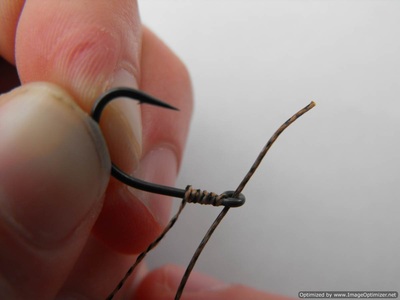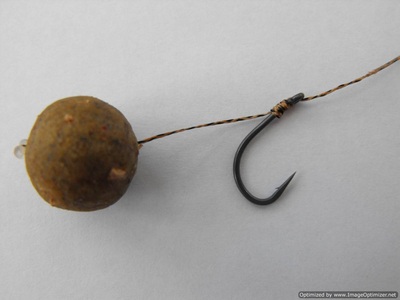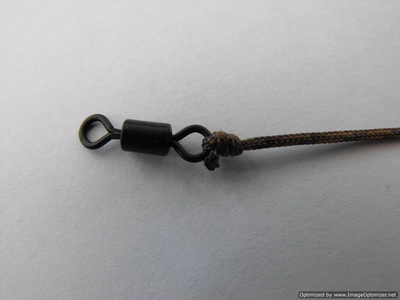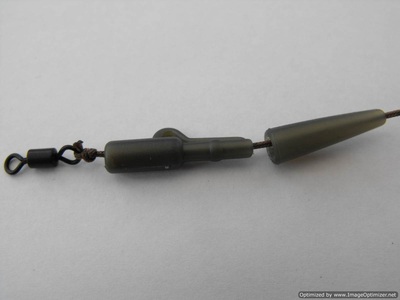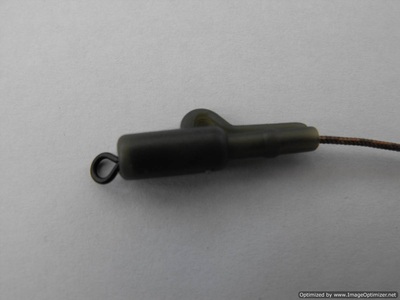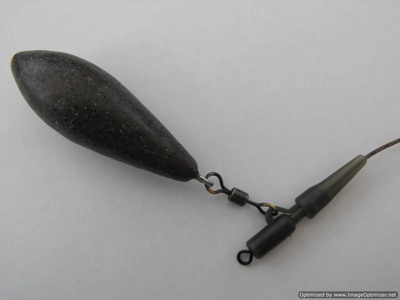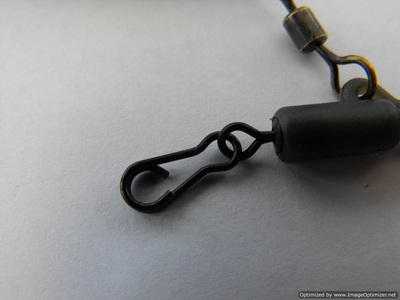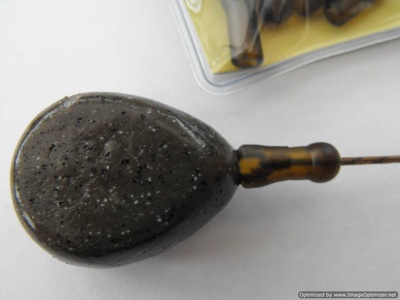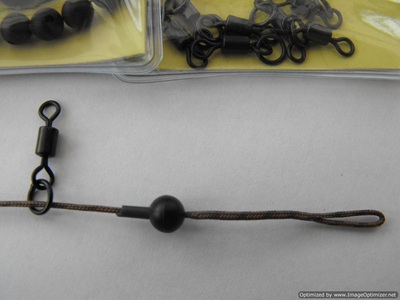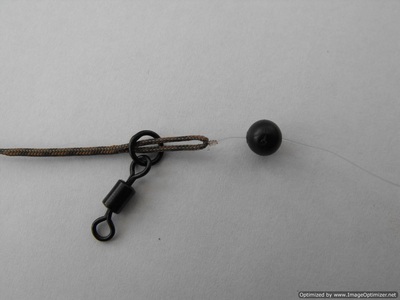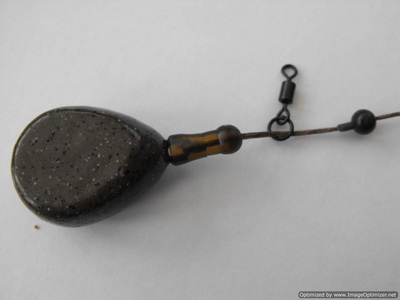SPECIMEN CARP FISHING
This is where the angler moves from quantity to quality. This style of fishing is predominantly aimed at catching massive carp but can also be used for various other species. Catching massive carp requires perseverance, an extensive knowledge and understanding of the fish and its habitat as well as good quality equipment. This is almost like fishing in a different league. There are, according to some reports, an estimated 2,5 million Specimen anglers around the world and this is no coincidence. My aim is to provide the beginner Specimen angler with the basic knowledge of this style of fishing and in due coarse will add more interesting and detailed articles. The library on Specimen fishing is absolutely massive, the choices of bait and tactics almost endless, the camping gear and other kit highly specialised, combining all this and applying it in beautiful natural surrounding is the reason why this style of fishing is so popular and growing all over the world.
This is where the angler moves from quantity to quality. This style of fishing is predominantly aimed at catching massive carp but can also be used for various other species. Catching massive carp requires perseverance, an extensive knowledge and understanding of the fish and its habitat as well as good quality equipment. This is almost like fishing in a different league. There are, according to some reports, an estimated 2,5 million Specimen anglers around the world and this is no coincidence. My aim is to provide the beginner Specimen angler with the basic knowledge of this style of fishing and in due coarse will add more interesting and detailed articles. The library on Specimen fishing is absolutely massive, the choices of bait and tactics almost endless, the camping gear and other kit highly specialised, combining all this and applying it in beautiful natural surrounding is the reason why this style of fishing is so popular and growing all over the world.
So you’re thinking of starting Specimen fishing right? Well, you’ve just come to the right place, this guide is packed with information and explanations about everything someone new to Specimen fishing should need to know.
A basic list of what you are likely to need and lastly how to use it!
1. Rods
2. Reels
3. Rod pod and Banksticks
4. Bite alarms
5. Bite indicators
6. Landing net and unhooking mat
7. Terminal tackle
8. Scale and weigh sling
9. Bait
10. Spod / bait rocket
10. Tacklebox and luggage
11. Camping equipment
12. Rigs
13. GOING FISHING!!!
A basic list of what you are likely to need and lastly how to use it!
1. Rods
2. Reels
3. Rod pod and Banksticks
4. Bite alarms
5. Bite indicators
6. Landing net and unhooking mat
7. Terminal tackle
8. Scale and weigh sling
9. Bait
10. Spod / bait rocket
10. Tacklebox and luggage
11. Camping equipment
12. Rigs
13. GOING FISHING!!!
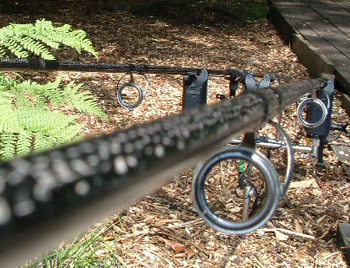
1. Rods
There are a baffling array of rods out there on the market today with prices ranging from £15 to £300+ but a rod’s a rod right?….
Wrong, it’s all about quality (and sometimes though you’re paying out for a brand name). A reasonably good quality rod can be got for around £50 - £100 each, now one term that crops up regularly is Test Curve or TC as it’s commonly stated, the test curve of a rod is a guide to it’s action and power.
It is usually meant as the weight required at the tip to bend the tip through 90 degrees from the butt. The ‘action’ of a rod can really fall into three categories which define how the rod bends under load. Firstly there are Through Action rods ‘slow taper’ which are softer meaning that the rod will bend throughout it’s length right through to the butt which is ideal for close-up work but will make it harder to control a fish at distance and not very suitable for casting larger leads over any real distance.
Secondly there are Medium action ‘medium taper’ rods that are slightly more rigid towards the butt meaning that they have more power to play fish and control a fish at some distance, are capable of casting medium size leads at reasonable distance but are still supple enough to control a fish under the rod tip (most people opt for this type of rod as a good all-rounder).
Finally there are Fast Action ‘fast taper’ rods tend to have more power in the butt and mid-section of the rod making them ideal for distance casting as the rod compresses less under weight, they tend to have a higher TC than slow or medium taper rods, overall this means the rod is a lot stiffer and as such can make controlling a fish at close range a lot more difficult. With that said, spend time in the shop with rods fully assembled and fitted with your choice of reel to get a feel for the rod and check that the rod doesnt have a ‘sloppy’ action.
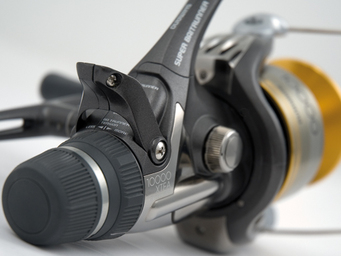
2. Reels:
Shimano revolutionised carp fishing with the ‘baitrunner’ system which allows a separate drag to be switched in effectively allowing the reel to free-spool and in turn allowing a fish to take line with a closed bail arm. This has made things much simpler for anglers and nowadays many reels have this facility incorporated usually under a different name.
There are several good reels out there such as the Shimano Baitrunner and Fox Stratos but there are plenty of cheaper alternatives which are pretty comparable in performance from brands such as Okuma and Zebco.
Big Pit reels are designed with huge line capacity in mind for fishing extreme distance but from personal experience i’ve found that many of these big pit reels dont feel well balanced when fitted to certain rods so it’s worth trying one fitted to the rod before considering purchasing.
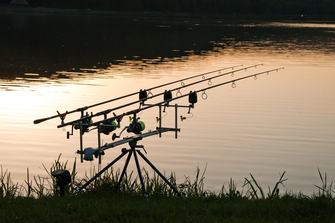
3. Rod Pods and Banksticks:
Now, when it comes to rod support you have two choices really here, go for a rod pod or banksticks and buzzer bars. Now assuming you’re coming to Specimen fishing from a general coarse fishing background then you’ll already be familiar with banksticks but probably less familiar with rod pods.
A rod pod is a effectively a framework with banksticks that normally offers considerably more support than banksticks and can be used on rigid surfaces such as concrete without needing to be pushed into the ground like a bankstick does, the downside is that they can be a real pain to set up on steep banks where banksticks would be much simpler.
If you decide to take the bankstick route then try to get the screw-in type as they are much easier to get into dry mud banks that normal push-in types are and the much greater ease of use far outweights the small additional cost.
If you decide to go for a pod then there are several good pods out there made by a variety of manufacturers such as Solar, Fox, Nash and many others but be sure to check that everything is pretty solid and be sure to see it assembled in the shop due to the fact that although there are plenty of good quality pods out there there’s also plenty of rubbish ones too.
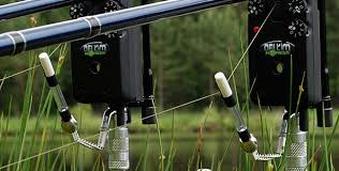
4. Bite Alarms:
These days bite alarms are an invaluable tool in Specimen fishing providing an audible and often visual indication of bites. There are many brands and designs out there with varying features. Most typical designs work on the roller wheel principle which has been in use for many years and often internally the alarms have a segmented disc attached to the wheel and this operates a beam-break sensor, the only downside being that due to having a segmented disc a certain degree of movement is required before the alarm actually provides an indication of the line movement.
Then there is one other design that is currently in use (used by Delkim) which works by sensing line vibration, this requires no moving parts such as a roller wheel. Features to look for are Adjustable Volume and Tone, this way the volume can be adusted down to be less annoying to other anglers during daylight hours. The tone adjustment can be handy as you can adjust the tone in case other anglers are using similar sounding alarms.
Try to get alarms that allow provision for attaching an external sounder box, there are mainly 2 ways to achieve this
1) through a wired connection plugging in to a socket on the alarm
2) wireless via a radio transmitter either built into the alarm or as an additional module that can be purchased separately.
If option 2 appeals to you then its best advised to check the price difference between the external transmitters versus the alarms with them built in.
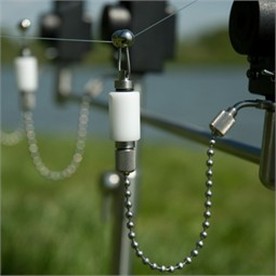
5. Bite Indicators:
Bite indicators are really a necessity although this is mixed opinion. It can make registering a bite a lot more positive and can give a good indication of what a fish is actually doing with your bait. For example a rising indicator would indicate that the fish is moving away from you where a dropping indicator would indicate what is known as a drop back which means the fish has picked up the bait and is moving towards you with it. Without an indicator this type of bite would be hard to register and may not even cause the alarm to sound, simply because the line is not heavy enough to move through the alarm by itself.
There are many designs of indicator and none are really technically superior or better than any other, the most popular seems to be the Fox or Solar swinger designs but conventional bobbin designs are just as good, be sure to look out for designs that allow you to incorporate a starlight or isotope to help you out when night fishing, recently more designs are being introduced that can be connected to your bite alarms allowing the indicator to be electrically illuminated for night fishing, normally you would have to use an indicator that is compatible with the type of alarm you have.
Bite indicators are really a necessity although this is mixed opinion. It can make registering a bite a lot more positive and can give a good indication of what a fish is actually doing with your bait. For example a rising indicator would indicate that the fish is moving away from you where a dropping indicator would indicate what is known as a drop back which means the fish has picked up the bait and is moving towards you with it. Without an indicator this type of bite would be hard to register and may not even cause the alarm to sound, simply because the line is not heavy enough to move through the alarm by itself.
There are many designs of indicator and none are really technically superior or better than any other, the most popular seems to be the Fox or Solar swinger designs but conventional bobbin designs are just as good, be sure to look out for designs that allow you to incorporate a starlight or isotope to help you out when night fishing, recently more designs are being introduced that can be connected to your bite alarms allowing the indicator to be electrically illuminated for night fishing, normally you would have to use an indicator that is compatible with the type of alarm you have.
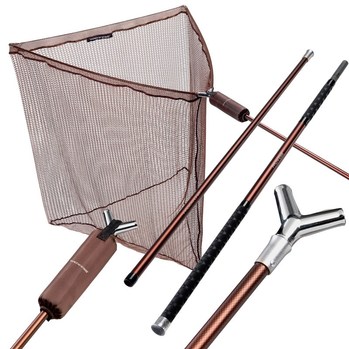
6. Landing Nets & Unhooking Mats:
A good quality landing net is essential, not just for making things easier for you but more importantly for the welfare of the fish you’re landing and handling. Large coarse mesh will damage the fish, lift scales and abrade the body scraping off the protective mucus. Using a fine mesh good quality net will help to reduce harm to the fish.
For this reason a good quality unhooking mat is also an essential. It is possible to get combined unhooking mat and weigh slings which make handling larger fish a lot easier as there is no need to transfer the fish from the unhooking mat to the weigh sling and the same sling is often contoured to support the fish. These ones are a little more pricey but definitely worth it.

7. Terminal Tackle:
Well, there’s no point having shiny new rods, reels and everything else without anything to put on the end of them
7.1 Main line:
First main consideration here is your main line, there are a bewildering array of lines to choose from, a line that has proved very popular for many years is Daiwa Sensor and so is Berkley Trilene. It is quite common nowadays to use braid in place of conventional line which offers many advantages, firstly braid is less likely to get damaged by underwater snags and mussels and has very little memory meaning that it doesn’t retain its coiling effect and has very little stretch that comes in handy when fishing next to snags.
If you prefer to use a traditional monofilament line then you may want to consider using a fluorocarbon line as this appears transparent in water and is less likely to be obvious to fish.
Follow the manufacturers instructions on loading your spools as you don't want to introduce any line-twist as this is the biggest cause of tangles ‘birds-nests’ on reels. The best way to fill your reel is to do it with the line spool laying on the floor with the label facing up.
7.2 Weights / Leads:
Leads are available in many shapes, colours and sizes. The two main groups that you gat are 'inline" and "pendant" style leads. Choosing a lead is determined by the colour and makeup of the lake bed, how the fish are feeding and at what distance you are fishing. The lead is the biggest item of your rig and getting it to blend in properly will contribute to the effectiveness of your underwater presentation.
7.3 Hooks:
Hooks are another important matter and again are mainly a matter of preference as to size and shape but the latter is really dependant on the design of the rig you’re using. The following is a very basic guide to match hook and bait sizes.
Hook size 10: 3 x Corn on hair, Boilies and pellets 8 - 10mm
Hook size 8: Boilies size 12 - 14mm
Hook size 6: Boilies size 16 - 18mm
Hook size 4 & 2: Boilies size 20mm+
For more information on rigs check out our rigs section further down.
7.4 Hooklink:
Effective balanced presentation relies upon the way a baited rig settles, and how it behaves and reacts to fish sucking at the hookbait. All of these characteristics are affected by the material, length and breaking strain of hooklink used when constructing our end tackle.
There is a huge variety available, enough to confuse even experienced anglers, let alone those starting out in Specimen fishing so we will offer a brief insight into the uses and benefits of the main varieties commonly used by Specimen anglers today.
Monofilaments – Copolymer and Fluorocarbon:
Often overlooked, monofilament hooklinks can range from a section of line taken from your fishing reel, through to specialised hook links like soft low memory HydroFlex, or super stiff Trip-Wire (that is recommended for Chod Rigs and Hinged Stiff rigs). They are easy to work with, and Copolymers offer exceptionally high knot strength with most commonly used knots, like the Grinner and Palomar knot.
‘Monofilaments’ aren’t only nylon and copolymer, they can also be made from Fluorocarbon materials. In recent years Fluorocarbons, like Mirage and Subterfuge, have become increasingly popular because of the weight of the line and the way that it becomes invisible when submerged. This is thanks to pure Fluorocarbon having the same refractive properties as water. Different varieties of Fluorocarbon offer different stiffness’s, and as such can be used for many different advanced rig applications.
Monofilaments are a great alternative to braided hooklinks as they are less prone to tangling, and holds the hook in a set position in relation to the hooklink. This is an important consideration when designing rigs that have a greater chance of pricking the fish when they are being blown out (anti-ejection rigs).
Ignore monofilaments at your peril – if the fish in your water have been caught over and over on a braid or skin then maybe it’s time to experiment. Small changes like this can make a big difference.
Braids:
Uncoated braids offer unsurpassed limpness that is said to give the hook bait a freedom of movement that can fool fish into thinking that the bait is a freebie. Whether it is this effect, or simply that the supple nature of these materials feel different to monofilaments on the fishes lip, or that the hook is free to twist uninhibited and take hold more effectively in the fish’s mouth is really uncertain. It’s probably a mix of all these attributes that makes braid so effective.
The perfect hook link braid should sink flush to the lake bed, be smooth to the touch and ultra limp, have a low diameter and be nicely camouflaged against a number of lake beds.
The subtlety that braids offer make them an extraordinarily effective hooklink option, and are the first choice for many anglers; especially if fishing with solid PVA bag or small hook baits.
Skins:
Skinned braided hooklinks are immensely popular and it’s not surprising when you consider the enormous variety of rigs that can be constructed using them.
They offer the angler the advantages of a soft braid that can be exposed by stripping the outer skin away, but without the tangles. The skin also helps the hooklink sink faster and makes the hooklink more robust as it offers the braided inner a little extra protection should the link come into contact with a submerged obstacle.
The colour and texture of the outer skins and braided inners varies between products. Apart from this the main difference is colours, with subtle variations between the types giving you the very best opportunity to match the lake bed of the water where you are angling.
The simplest bottom bait rigs, incorporating a small stripped portion at the hook end, have caught countless big fish all around the world. However the scope for experiment is almost endless. Simply by taking small sections of skin away you can dramatically alter the way in which the hook reacts when the bait is inhaled by a feeding fish.
Suitable for almost any modern rig including pop up and bottom bait rigs, there is little wonder skins are probably used by more anglers than any other hooklink today. They are awesome!
Well, there’s no point having shiny new rods, reels and everything else without anything to put on the end of them
7.1 Main line:
First main consideration here is your main line, there are a bewildering array of lines to choose from, a line that has proved very popular for many years is Daiwa Sensor and so is Berkley Trilene. It is quite common nowadays to use braid in place of conventional line which offers many advantages, firstly braid is less likely to get damaged by underwater snags and mussels and has very little memory meaning that it doesn’t retain its coiling effect and has very little stretch that comes in handy when fishing next to snags.
If you prefer to use a traditional monofilament line then you may want to consider using a fluorocarbon line as this appears transparent in water and is less likely to be obvious to fish.
Follow the manufacturers instructions on loading your spools as you don't want to introduce any line-twist as this is the biggest cause of tangles ‘birds-nests’ on reels. The best way to fill your reel is to do it with the line spool laying on the floor with the label facing up.
7.2 Weights / Leads:
Leads are available in many shapes, colours and sizes. The two main groups that you gat are 'inline" and "pendant" style leads. Choosing a lead is determined by the colour and makeup of the lake bed, how the fish are feeding and at what distance you are fishing. The lead is the biggest item of your rig and getting it to blend in properly will contribute to the effectiveness of your underwater presentation.
7.3 Hooks:
Hooks are another important matter and again are mainly a matter of preference as to size and shape but the latter is really dependant on the design of the rig you’re using. The following is a very basic guide to match hook and bait sizes.
Hook size 10: 3 x Corn on hair, Boilies and pellets 8 - 10mm
Hook size 8: Boilies size 12 - 14mm
Hook size 6: Boilies size 16 - 18mm
Hook size 4 & 2: Boilies size 20mm+
For more information on rigs check out our rigs section further down.
7.4 Hooklink:
Effective balanced presentation relies upon the way a baited rig settles, and how it behaves and reacts to fish sucking at the hookbait. All of these characteristics are affected by the material, length and breaking strain of hooklink used when constructing our end tackle.
There is a huge variety available, enough to confuse even experienced anglers, let alone those starting out in Specimen fishing so we will offer a brief insight into the uses and benefits of the main varieties commonly used by Specimen anglers today.
Monofilaments – Copolymer and Fluorocarbon:
Often overlooked, monofilament hooklinks can range from a section of line taken from your fishing reel, through to specialised hook links like soft low memory HydroFlex, or super stiff Trip-Wire (that is recommended for Chod Rigs and Hinged Stiff rigs). They are easy to work with, and Copolymers offer exceptionally high knot strength with most commonly used knots, like the Grinner and Palomar knot.
‘Monofilaments’ aren’t only nylon and copolymer, they can also be made from Fluorocarbon materials. In recent years Fluorocarbons, like Mirage and Subterfuge, have become increasingly popular because of the weight of the line and the way that it becomes invisible when submerged. This is thanks to pure Fluorocarbon having the same refractive properties as water. Different varieties of Fluorocarbon offer different stiffness’s, and as such can be used for many different advanced rig applications.
Monofilaments are a great alternative to braided hooklinks as they are less prone to tangling, and holds the hook in a set position in relation to the hooklink. This is an important consideration when designing rigs that have a greater chance of pricking the fish when they are being blown out (anti-ejection rigs).
Ignore monofilaments at your peril – if the fish in your water have been caught over and over on a braid or skin then maybe it’s time to experiment. Small changes like this can make a big difference.
Braids:
Uncoated braids offer unsurpassed limpness that is said to give the hook bait a freedom of movement that can fool fish into thinking that the bait is a freebie. Whether it is this effect, or simply that the supple nature of these materials feel different to monofilaments on the fishes lip, or that the hook is free to twist uninhibited and take hold more effectively in the fish’s mouth is really uncertain. It’s probably a mix of all these attributes that makes braid so effective.
The perfect hook link braid should sink flush to the lake bed, be smooth to the touch and ultra limp, have a low diameter and be nicely camouflaged against a number of lake beds.
The subtlety that braids offer make them an extraordinarily effective hooklink option, and are the first choice for many anglers; especially if fishing with solid PVA bag or small hook baits.
Skins:
Skinned braided hooklinks are immensely popular and it’s not surprising when you consider the enormous variety of rigs that can be constructed using them.
They offer the angler the advantages of a soft braid that can be exposed by stripping the outer skin away, but without the tangles. The skin also helps the hooklink sink faster and makes the hooklink more robust as it offers the braided inner a little extra protection should the link come into contact with a submerged obstacle.
The colour and texture of the outer skins and braided inners varies between products. Apart from this the main difference is colours, with subtle variations between the types giving you the very best opportunity to match the lake bed of the water where you are angling.
The simplest bottom bait rigs, incorporating a small stripped portion at the hook end, have caught countless big fish all around the world. However the scope for experiment is almost endless. Simply by taking small sections of skin away you can dramatically alter the way in which the hook reacts when the bait is inhaled by a feeding fish.
Suitable for almost any modern rig including pop up and bottom bait rigs, there is little wonder skins are probably used by more anglers than any other hooklink today. They are awesome!
7.5 PVA products:
If you look inside the tackle box of any specimen angler in any country where specimen fishing is popular, one item you will always find in one form or another will be P.V.A., or Poly Vinyl Alcohol, to give it its full name.
This remarkable product was first used in fishing by sea anglers who used PVA Tape to help tie up their rigs to prevent tangles on
casting. The beauty of PVA is its strength when dry and its ability to completely dissolve when immersed in water, without affecting
or harming its immediate environment in any way (including the fish!).
The original PVA String is strong enough to withstand even long distance casting thus enabling you to fish ‘free’ offerings, the same as your hookbait, at any range.
PVA Bags, as opposed to string, allow other baits to be used such as dry particles or groundbaits. The contents of your PVA Bag makes a great attractor for your hookbait to lie in once the PVA has melted. Taking this one stage further, it is also possible to encapsulate your entire rig inside the PVA Bag before casting. This clever idea has a number of advantages –
1) It is more aerodynamic than casting a PVA Bag hanging off a rig hook in the normal manner.
2) Presentation of your rig, even when fishing in weed or silt, is much improved due to the hook, hookbait and rig being ‘protected’ until the PVA has melted.
3) Your hookbait is always right in amongst the contents of the PVA Bag as opposed to ‘nearby’ or alongside, thus far less suspicious to the fish.
Another major step forward in PVA has been the introduction of Mesh or ‘Stocking’ type PVA. This allows water to pass through, within and around the PVA parcel and its contents, a lot easier which speeds up the meltdown considerably. It is also very strong when dry and lends itself to knotting far more readily than the solid bags. Different gauges allow for different water conditions and different baits. A fine mesh allows the use of small pellets, narrow tubing to accommodate boillies in a tight group and now there are several PVA loading tools to help get the best out of your PVA mesh or bag.
Again, is it good practice for the bait and rig to be fished ‘inside’ the PVA Bag and there are special ‘Stick Mix’ needles
available to help you achieve this.
If you look inside the tackle box of any specimen angler in any country where specimen fishing is popular, one item you will always find in one form or another will be P.V.A., or Poly Vinyl Alcohol, to give it its full name.
This remarkable product was first used in fishing by sea anglers who used PVA Tape to help tie up their rigs to prevent tangles on
casting. The beauty of PVA is its strength when dry and its ability to completely dissolve when immersed in water, without affecting
or harming its immediate environment in any way (including the fish!).
The original PVA String is strong enough to withstand even long distance casting thus enabling you to fish ‘free’ offerings, the same as your hookbait, at any range.
PVA Bags, as opposed to string, allow other baits to be used such as dry particles or groundbaits. The contents of your PVA Bag makes a great attractor for your hookbait to lie in once the PVA has melted. Taking this one stage further, it is also possible to encapsulate your entire rig inside the PVA Bag before casting. This clever idea has a number of advantages –
1) It is more aerodynamic than casting a PVA Bag hanging off a rig hook in the normal manner.
2) Presentation of your rig, even when fishing in weed or silt, is much improved due to the hook, hookbait and rig being ‘protected’ until the PVA has melted.
3) Your hookbait is always right in amongst the contents of the PVA Bag as opposed to ‘nearby’ or alongside, thus far less suspicious to the fish.
Another major step forward in PVA has been the introduction of Mesh or ‘Stocking’ type PVA. This allows water to pass through, within and around the PVA parcel and its contents, a lot easier which speeds up the meltdown considerably. It is also very strong when dry and lends itself to knotting far more readily than the solid bags. Different gauges allow for different water conditions and different baits. A fine mesh allows the use of small pellets, narrow tubing to accommodate boillies in a tight group and now there are several PVA loading tools to help get the best out of your PVA mesh or bag.
Again, is it good practice for the bait and rig to be fished ‘inside’ the PVA Bag and there are special ‘Stick Mix’ needles
available to help you achieve this.
7.6 Rig bits:
Boilie or bait stops, are used to prevent your bait from coming of the hair. Other items are swivels, shrink tubing, Hooklink clips, lead clips, safety lead clips and sleeves, rubber beads (protect knots), anti-tangle sleeves and helicopter rig components. Lead shot or putty is a must have when fishing with pop-up and also comes in handy if you want to pin down any part of your rig. Leadcore, this links your mainline and rig, it is much heavier than your mainline and will therefor lie flat on the bottom and out the way of approaching fish. Main line tubing, this goes over the last 60 - 80 cm of your main line and helps to pin it down, available in different colours for camouflage and also prevents line or braid damage to the fishes scales. The choosing between whether to use Mainline tubing or Leadcore is up to the anglers personal preference.
Boilie or bait stops, are used to prevent your bait from coming of the hair. Other items are swivels, shrink tubing, Hooklink clips, lead clips, safety lead clips and sleeves, rubber beads (protect knots), anti-tangle sleeves and helicopter rig components. Lead shot or putty is a must have when fishing with pop-up and also comes in handy if you want to pin down any part of your rig. Leadcore, this links your mainline and rig, it is much heavier than your mainline and will therefor lie flat on the bottom and out the way of approaching fish. Main line tubing, this goes over the last 60 - 80 cm of your main line and helps to pin it down, available in different colours for camouflage and also prevents line or braid damage to the fishes scales. The choosing between whether to use Mainline tubing or Leadcore is up to the anglers personal preference.
7.7 Baiting tools:
The boilie needle is an important tool and is primarily use to get your bait onto the hair rig. Baits like boilies, tiger-nuts, maple peas and peanuts are hard and you will need this little tool to thread your bait onto before you slide it over to the hair rig.
Long boilie needles are essential for making PVA strings (Freebies attached to hair rig) or PVA stick mixes.
The particle / Boilie drill is another important tool. When the bait is to hard for the boilie needle to go through, the drill is used to make a pilot hole.
7.8 Rig tools and accessories:
These items make life easy, scissors and nail clippers for cutting line, hooklinks etc. Tension bar and Long nose pliers to tie and tighten hooklinks and rigs. Splicing needle to splice Leadcore. Lighter for use with shrink tubing.
The boilie needle is an important tool and is primarily use to get your bait onto the hair rig. Baits like boilies, tiger-nuts, maple peas and peanuts are hard and you will need this little tool to thread your bait onto before you slide it over to the hair rig.
Long boilie needles are essential for making PVA strings (Freebies attached to hair rig) or PVA stick mixes.
The particle / Boilie drill is another important tool. When the bait is to hard for the boilie needle to go through, the drill is used to make a pilot hole.
7.8 Rig tools and accessories:
These items make life easy, scissors and nail clippers for cutting line, hooklinks etc. Tension bar and Long nose pliers to tie and tighten hooklinks and rigs. Splicing needle to splice Leadcore. Lighter for use with shrink tubing.
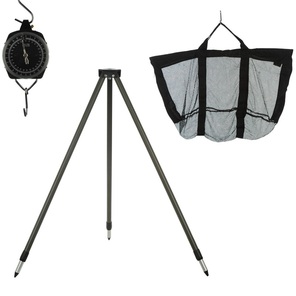
8. Scale and weigh sling:
Specimen fishing is about size and weight. Having a good quality scale is therefor very important to confirm the exact weight and to give you piece of mind and full confidence when bragging with your catch.
Having a proper weigh sling is also important but make sure you thoroughly wet the sling before putting the fish in. Remember to zero the scale to allow for the weight of the wet sling – no cheating!!!
A tripod or scale support is also a handy item and will make weighing your fish more accurate and a lot easier.
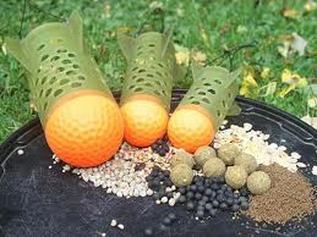
9. Bait:
When preparing to go specimen carp fishing one of the most important aspects is choosing and preparing your baits. The baits must be properly prepared for your success as well as for the fish's safety.
Boilies:
They are boiled paste fishing baits. Usually combinations of fishmeal, milk proteins, bird foods, semolina and soya flour, which are mixed with eggs as a binding agent and then boiled to form hard round baits which will last in the water. Additional flavourings and attractors are also usually included in the mix. The round shape allows the baits to be catapulted accurately when fishing at range.
First formulated in the 1970s, the boilie was the invention of Fred Wilton. Boiled baits also meant that they could be left longer in the water without fear that they had fallen off the hook, in the same way as bread or other traditional baits might. Boilies are now one of the most established baits, available in a huge range of colours and flavours. Boilies come in all different shapes and sizes, from tiny micro boilies (some even as small as eight millimetres) up to as large as 40 mm which are more suited to waters where 'nuisance fish' are present.
There are buoyant boilies, commonly known as pop-ups, that are used to make the bait sit just off the bed of the lake making them easier for the fish to find and take. Pop-ups can be used in various situations, where there is weed or silt present on a lake bed, or with a normal boilie to create a 'snowman' rig, the pop-up is generally smaller than the normal boilie, this creates what is known as a critically balanced bait, or neutral buoyancy, and makes it easier for the fish to take in the bait.
The carp angler has many types of boilies to choose from, some of which have added preservatives in them so that they can be kept at room temperature on shop shelves for a long time (shelf-life bait). Boilies that lack these added preservatives need to be refrigerated or frozen to stop them from going off; these are known as freezer baits. There have been many arguments discussing the pros and cons of both freezer and shelf-life boilies but the common opinion of many anglers is that due to the artificial preservatives in shelf-life baits they are not as nutritionally beneficial to the fish and therefore lack some attraction. Also, since in order to keep freezer baits fresh they need to be frozen soon after being rolled, not only will the ingredients used be of a much higher quality than in shelf lives but the ingredients used to make them will not lose much of their nutrients and attraction before being used in a fishing situation (much like frozen vegetables). Due to these facts freezer baits are often much more expensive than their shelf life counterparts.
The most commonly used set-up anglers use to present a boilie is a hair rig (the bait is not attached directly to the hook) which allows the boilie to sit off the back of the hook. This not only means that the bait will behave more naturally in the water (for example when disturbed by feeding fish) it also will often make the difference between a good hook hold and a bad one. Due to the nature in which a fish feeds the bait is blown out of the mouth soon after it has been picked up and the fact that the bait can move independently from the hook it allows the hook to stay back inside the mouth and find its way preferably into the bottom lip.Different sizes of boilies are used depending on the size of the fish you are targeting. Flavours are also dependent on the venue you will be targeting. You may often encounter bites from other species or smaller fish may also pick up these boilies, if smaller carps pick up your boilies you may want to switch to larger sized boilies to weed out the smaller fish from biting and taking away the opportunity of a big fish picking up your bait.
Sweetcorn / Maize:
This is arguably one of the best baits ever! It continues to catch a lot of fish of all sizes year in and year out. It’s cheap to buy and it’s colour and taste make it highly visible and attractive – they find the stuff irresistible! Also any amino acids that the corn gives off will travel through the water layers which is very attractive and will draw the fish in.
Another type of corn is maize, it’s from the same family but has less sugar content. Unprepared maize can be bought in bulk and is usually very cheap. Always remember to prepare the maize properly as it can be very harmful to the fish if it isn’t cooked correctly. To prepare safely you first need to soak the maize in cold water for 24 hours (the longer the better). Then boil the maize and simmer for about 30 minutes. At this point you can add your own liquid attractors before leaving the maize to soak in their own juicies in an airtight bucket for another couple of hours. You can always tell if the maize is ready because it expands and you should be able to split the maize when pinched. The beauty of this bait is that you can use it as a hookbait or mixed in with groundbait, and as part of a spod mix.
Make sure you buy the tins with added sugar and salt because this is a huge attraction for fish. Another main attractor for this bait is its rich content of vitamins, minerals, sodium and amino acids which fish can pick up on from some distance and will home in on the scent – just like somebody ringing the dinner bell!
Peanuts:
This is another favoured carp bait BUT extreme care must be taken that it doesn’t have skin, as this may be harmful to fish. To prepare the peanuts you can soak them for 48 hours in warm water and then cook for about 30 minutes, until the peanut is soft. The peanuts can then be used on a hair rig or in your ground feed mix. Australian farmed peanuts undergo strict safety tests and should therefor be your first choice. The carp really loves peanuts, probably from a combination of the oiliness, the smell and the obvious nutritional value that exists in the peanuts.
Chickpeas:
Have to be one of the most underrated carp baits out there. It can be used as hookbait or form part of groundbait or spod mix.
Chickpeas are cheap to buy and can be bought in a tin off the shelf, ready to use. Alternatively you can buy dried chickpeas in bulk which are very cheap and will last you a long time. You just need to be careful when preparing dried chickpeas because they can be harmful to the fish if they are not prepared properly. Remember to add salt and any other attractors, flavours and colourants you might want to the water, when preparing dried chickpeas. The easiest way to prepare chickpeas is to soak overnight (12 – 16 hours) and then the next day, bring them to the boil for about 30 minutes and the chickpeas should be good to go.
Maple Peas:
Maple peas are a really good bait and can also be used as a substitute for tiger-nuts . The preparation of the maple peas is to soak for about 12 hours and then cook at a medium heat for around 5 to 6 hours. The peas can then be used as a hook-bait or in your ground-feed. Maple peas are available in Australia and is a an excellent addition to any particle blends.
Hemp seeds are used inside your ground-feed and gets into all the nooks and crannies to keep the carp in your feed longer as they are trying to pick up these seeds. Carp really do love hemp seeds. To prepare the seeds you need to soak them for about 12 hours and then cook for about 15 minutes or until the seed starts sprouting, when they are ready. The hemp seeds have a really great smell and that is probably the main factor that attracts carp to this ingredient of the particle mix.
Particle mix:
The particle mix or particle-blend is a blend of different types of seeds (like mixed bird seed) and serves the purpose of adding some variety to the menu. It serves as an attractant and keeps the fish occupied and in your swim. The preparation of the particle-blend is done by soaking it for 12 hours and then you cook it for about 15 minutes. The particle mix can be used on it's own or you can add it to your groundbait.
Pellets:
The Koi pellets or fish pellets can be bought from Aquaponics or pet shops and can be added to your groundbait. The pellets are really nutritional and serves as a great attractant. The attracting aspect is always a good reason to add them to your ground-bait.
When preparing to go specimen carp fishing one of the most important aspects is choosing and preparing your baits. The baits must be properly prepared for your success as well as for the fish's safety.
Boilies:
They are boiled paste fishing baits. Usually combinations of fishmeal, milk proteins, bird foods, semolina and soya flour, which are mixed with eggs as a binding agent and then boiled to form hard round baits which will last in the water. Additional flavourings and attractors are also usually included in the mix. The round shape allows the baits to be catapulted accurately when fishing at range.
First formulated in the 1970s, the boilie was the invention of Fred Wilton. Boiled baits also meant that they could be left longer in the water without fear that they had fallen off the hook, in the same way as bread or other traditional baits might. Boilies are now one of the most established baits, available in a huge range of colours and flavours. Boilies come in all different shapes and sizes, from tiny micro boilies (some even as small as eight millimetres) up to as large as 40 mm which are more suited to waters where 'nuisance fish' are present.
There are buoyant boilies, commonly known as pop-ups, that are used to make the bait sit just off the bed of the lake making them easier for the fish to find and take. Pop-ups can be used in various situations, where there is weed or silt present on a lake bed, or with a normal boilie to create a 'snowman' rig, the pop-up is generally smaller than the normal boilie, this creates what is known as a critically balanced bait, or neutral buoyancy, and makes it easier for the fish to take in the bait.
The carp angler has many types of boilies to choose from, some of which have added preservatives in them so that they can be kept at room temperature on shop shelves for a long time (shelf-life bait). Boilies that lack these added preservatives need to be refrigerated or frozen to stop them from going off; these are known as freezer baits. There have been many arguments discussing the pros and cons of both freezer and shelf-life boilies but the common opinion of many anglers is that due to the artificial preservatives in shelf-life baits they are not as nutritionally beneficial to the fish and therefore lack some attraction. Also, since in order to keep freezer baits fresh they need to be frozen soon after being rolled, not only will the ingredients used be of a much higher quality than in shelf lives but the ingredients used to make them will not lose much of their nutrients and attraction before being used in a fishing situation (much like frozen vegetables). Due to these facts freezer baits are often much more expensive than their shelf life counterparts.
The most commonly used set-up anglers use to present a boilie is a hair rig (the bait is not attached directly to the hook) which allows the boilie to sit off the back of the hook. This not only means that the bait will behave more naturally in the water (for example when disturbed by feeding fish) it also will often make the difference between a good hook hold and a bad one. Due to the nature in which a fish feeds the bait is blown out of the mouth soon after it has been picked up and the fact that the bait can move independently from the hook it allows the hook to stay back inside the mouth and find its way preferably into the bottom lip.Different sizes of boilies are used depending on the size of the fish you are targeting. Flavours are also dependent on the venue you will be targeting. You may often encounter bites from other species or smaller fish may also pick up these boilies, if smaller carps pick up your boilies you may want to switch to larger sized boilies to weed out the smaller fish from biting and taking away the opportunity of a big fish picking up your bait.
Sweetcorn / Maize:
This is arguably one of the best baits ever! It continues to catch a lot of fish of all sizes year in and year out. It’s cheap to buy and it’s colour and taste make it highly visible and attractive – they find the stuff irresistible! Also any amino acids that the corn gives off will travel through the water layers which is very attractive and will draw the fish in.
Another type of corn is maize, it’s from the same family but has less sugar content. Unprepared maize can be bought in bulk and is usually very cheap. Always remember to prepare the maize properly as it can be very harmful to the fish if it isn’t cooked correctly. To prepare safely you first need to soak the maize in cold water for 24 hours (the longer the better). Then boil the maize and simmer for about 30 minutes. At this point you can add your own liquid attractors before leaving the maize to soak in their own juicies in an airtight bucket for another couple of hours. You can always tell if the maize is ready because it expands and you should be able to split the maize when pinched. The beauty of this bait is that you can use it as a hookbait or mixed in with groundbait, and as part of a spod mix.
Make sure you buy the tins with added sugar and salt because this is a huge attraction for fish. Another main attractor for this bait is its rich content of vitamins, minerals, sodium and amino acids which fish can pick up on from some distance and will home in on the scent – just like somebody ringing the dinner bell!
Peanuts:
This is another favoured carp bait BUT extreme care must be taken that it doesn’t have skin, as this may be harmful to fish. To prepare the peanuts you can soak them for 48 hours in warm water and then cook for about 30 minutes, until the peanut is soft. The peanuts can then be used on a hair rig or in your ground feed mix. Australian farmed peanuts undergo strict safety tests and should therefor be your first choice. The carp really loves peanuts, probably from a combination of the oiliness, the smell and the obvious nutritional value that exists in the peanuts.
Chickpeas:
Have to be one of the most underrated carp baits out there. It can be used as hookbait or form part of groundbait or spod mix.
Chickpeas are cheap to buy and can be bought in a tin off the shelf, ready to use. Alternatively you can buy dried chickpeas in bulk which are very cheap and will last you a long time. You just need to be careful when preparing dried chickpeas because they can be harmful to the fish if they are not prepared properly. Remember to add salt and any other attractors, flavours and colourants you might want to the water, when preparing dried chickpeas. The easiest way to prepare chickpeas is to soak overnight (12 – 16 hours) and then the next day, bring them to the boil for about 30 minutes and the chickpeas should be good to go.
Maple Peas:
Maple peas are a really good bait and can also be used as a substitute for tiger-nuts . The preparation of the maple peas is to soak for about 12 hours and then cook at a medium heat for around 5 to 6 hours. The peas can then be used as a hook-bait or in your ground-feed. Maple peas are available in Australia and is a an excellent addition to any particle blends.
Hemp seeds are used inside your ground-feed and gets into all the nooks and crannies to keep the carp in your feed longer as they are trying to pick up these seeds. Carp really do love hemp seeds. To prepare the seeds you need to soak them for about 12 hours and then cook for about 15 minutes or until the seed starts sprouting, when they are ready. The hemp seeds have a really great smell and that is probably the main factor that attracts carp to this ingredient of the particle mix.
Particle mix:
The particle mix or particle-blend is a blend of different types of seeds (like mixed bird seed) and serves the purpose of adding some variety to the menu. It serves as an attractant and keeps the fish occupied and in your swim. The preparation of the particle-blend is done by soaking it for 12 hours and then you cook it for about 15 minutes. The particle mix can be used on it's own or you can add it to your groundbait.
Pellets:
The Koi pellets or fish pellets can be bought from Aquaponics or pet shops and can be added to your groundbait. The pellets are really nutritional and serves as a great attractant. The attracting aspect is always a good reason to add them to your ground-bait.
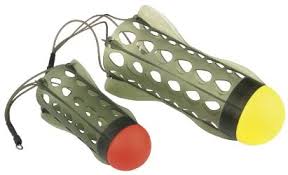
10. Spod / Bait rocket
The Spod is a tube like rocket. There are different designs, some are open at the back and others are fully enclosed and open on impact with the water. Some work easier than others but they all have the same job and that is to deliver freebies or groundbait to the spot where you want to fish. Large volumes can be delivered in a fairly short time. The idea generally is not to cast all over the place but to try and hit the same spot every time. Mastering the use of your Spod will add substantially to your ability to catch more and bigger fish!
If you are using pellets or particle baits which are fairly light, then by dipping your filled spod into the water will give it a bit more weight for casting.
The Spod is a tube like rocket. There are different designs, some are open at the back and others are fully enclosed and open on impact with the water. Some work easier than others but they all have the same job and that is to deliver freebies or groundbait to the spot where you want to fish. Large volumes can be delivered in a fairly short time. The idea generally is not to cast all over the place but to try and hit the same spot every time. Mastering the use of your Spod will add substantially to your ability to catch more and bigger fish!
If you are using pellets or particle baits which are fairly light, then by dipping your filled spod into the water will give it a bit more weight for casting.
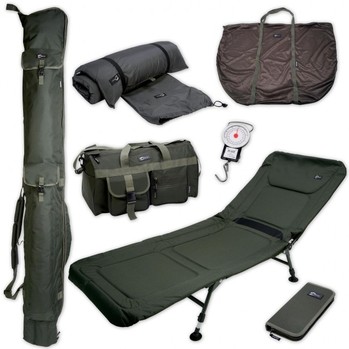
10. Tackle box and luggage:
There is no point buying gear if you do not have anything to put it in. Buying your gear can cost a small fortune and it is therefor very important that you luggage and tackle box are rugget and strong enough to do the job of protecting your gear. It is also important to look for luggage and tackle boxes with a sensible layout that will help you to be more efficient finding stuff and putting it away. Nothing is worse than arriving at your weekend spot only to find that your reel, rod tip or something else is broken. Buying quality gear will not only last longer but will also give you piece of mind and make your session more enjoyable.
There is no point buying gear if you do not have anything to put it in. Buying your gear can cost a small fortune and it is therefor very important that you luggage and tackle box are rugget and strong enough to do the job of protecting your gear. It is also important to look for luggage and tackle boxes with a sensible layout that will help you to be more efficient finding stuff and putting it away. Nothing is worse than arriving at your weekend spot only to find that your reel, rod tip or something else is broken. Buying quality gear will not only last longer but will also give you piece of mind and make your session more enjoyable.
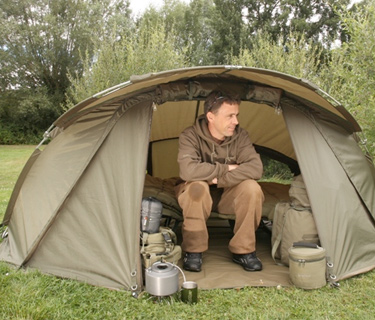
11. Camping equipment:
For many anglers night fishing can be a drama of disasters accidents and frustration as things just don’t go to plan. All fishing but especially night fishing is about being prepared and comfortable for and during the session so with that in mind let's look a few of the essentials you will need. These are a bivvy or shelter a comfortable bed chair and a sleeping bag.
Bivvy's, Brollies and shelters:
They come in all shapes, colour and sizes and can offer many different levels of comfort. The length of the session and the amount of equipment you take will have a big factor in the type and size of shelter or bivvy you buy. Most modern shelters now days can be bought as a single skin with the option of buying a second skin if needed. A single skin shelter are obviously lighter and can be a lot quicker to put up, however you can suffer from a lot of condensation build up inside the shelter. A twin skinned shelter will almost totally eliminate the condensation problem and will make the shelter a lot warmer if you ever intend to night fish during the colder months. When choosing the shelter, look at the size first of all, do you intend to fish with a partner or on your own ? Where you intend to fish, is the swim large so a big shelter is easily placed or are the swims small so you will need a more compact shelter to fit in the space you have. Look at how easy the shelter is to put up and put away and how small the shelter packs away as well as how heavy it is. Make sure you get a good quality thick ground sheet to make the floor of the shelter a much nicer place to walk on and keep moisture and a lot of the unwanted creepy crawlies out from under your feet.
For many anglers night fishing can be a drama of disasters accidents and frustration as things just don’t go to plan. All fishing but especially night fishing is about being prepared and comfortable for and during the session so with that in mind let's look a few of the essentials you will need. These are a bivvy or shelter a comfortable bed chair and a sleeping bag.
Bivvy's, Brollies and shelters:
They come in all shapes, colour and sizes and can offer many different levels of comfort. The length of the session and the amount of equipment you take will have a big factor in the type and size of shelter or bivvy you buy. Most modern shelters now days can be bought as a single skin with the option of buying a second skin if needed. A single skin shelter are obviously lighter and can be a lot quicker to put up, however you can suffer from a lot of condensation build up inside the shelter. A twin skinned shelter will almost totally eliminate the condensation problem and will make the shelter a lot warmer if you ever intend to night fish during the colder months. When choosing the shelter, look at the size first of all, do you intend to fish with a partner or on your own ? Where you intend to fish, is the swim large so a big shelter is easily placed or are the swims small so you will need a more compact shelter to fit in the space you have. Look at how easy the shelter is to put up and put away and how small the shelter packs away as well as how heavy it is. Make sure you get a good quality thick ground sheet to make the floor of the shelter a much nicer place to walk on and keep moisture and a lot of the unwanted creepy crawlies out from under your feet.
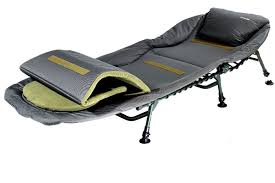
Bed chairs:
Like shelters, there are many bed chairs to choose from. Prices for bed chairs have been dropping in recent years however the quality of the chairs seems to be getting better and better. The bed chair frames are now made from either steel which makes them heavier but cheaper to buy or Aluminium which is a lot lighter but more expensive to purchase. Try if your budget allows to get a bed chair with at least three sets of legs if not four. Make sure the legs are individually adjustable, this will make the bed a lot more stable and comfortable to lay on. Bed chairs are now available for the larger angler, almost like a king size bed and with many different mattress types so there is no need to suffer from a bad night's sleep because of a poorly made cheap bed chair.
Like shelters, there are many bed chairs to choose from. Prices for bed chairs have been dropping in recent years however the quality of the chairs seems to be getting better and better. The bed chair frames are now made from either steel which makes them heavier but cheaper to buy or Aluminium which is a lot lighter but more expensive to purchase. Try if your budget allows to get a bed chair with at least three sets of legs if not four. Make sure the legs are individually adjustable, this will make the bed a lot more stable and comfortable to lay on. Bed chairs are now available for the larger angler, almost like a king size bed and with many different mattress types so there is no need to suffer from a bad night's sleep because of a poorly made cheap bed chair.
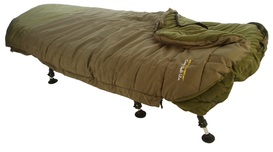
Sleeping bags:
It is important that the sleeping bag attaches to the top and bottom of the bed chair via straps or retraining sleeves and has side straps to stop the sleeping bag from slipping or sliding. Make sure the bag has strong easy to use side zip, sometimes called crash zips on either side so you can quickly exit the sleeping bag when you need to get the screaming take as you lay in your bed. Some of the bed chairs may well have integrated pillow in the mattress however if they don’t have a pillow get one that attached to the bed chair frame to ensure you don’t lose the pillow and can sleep comfortably.
You will be spending hours sitting around watching and tying rigs, make sure you have the best quality chair you can afford to make these periods pain free.
It is important that the sleeping bag attaches to the top and bottom of the bed chair via straps or retraining sleeves and has side straps to stop the sleeping bag from slipping or sliding. Make sure the bag has strong easy to use side zip, sometimes called crash zips on either side so you can quickly exit the sleeping bag when you need to get the screaming take as you lay in your bed. Some of the bed chairs may well have integrated pillow in the mattress however if they don’t have a pillow get one that attached to the bed chair frame to ensure you don’t lose the pillow and can sleep comfortably.
You will be spending hours sitting around watching and tying rigs, make sure you have the best quality chair you can afford to make these periods pain free.
Well, that’s pretty much the minimum of what you’ll need to get you started in carp fishing, obviously you can go with higher/lower quality items to fit your budget but please try to go for decent rods and reels otherwise you’ll only regret it later on and end up having to spend more in the long run.
12. RIGS:

Carp fishing is all about confidence, confidence in your bait, tackle and rigs. I want to cover some really basic rigs. We will start off with how to tie the Hair rig and then move on to the Inline Safety and Helicopter rigs. Both the Helicopter and the Inline Safety Rig can be referred to as being bolt-rigs, meaning that once the fish has been pricked by the hair-rig, it turns to run and the weight of the lead further imbeds the hook causing the fish to bolt, resulting in screaming alarms on the bank. Between these two rigs you should be in a position to fish in almost any conditions and adapt to most fishing situations.
The picture below is just a recap of some standard components that you will need to make your rigs:
The picture below is just a recap of some standard components that you will need to make your rigs:
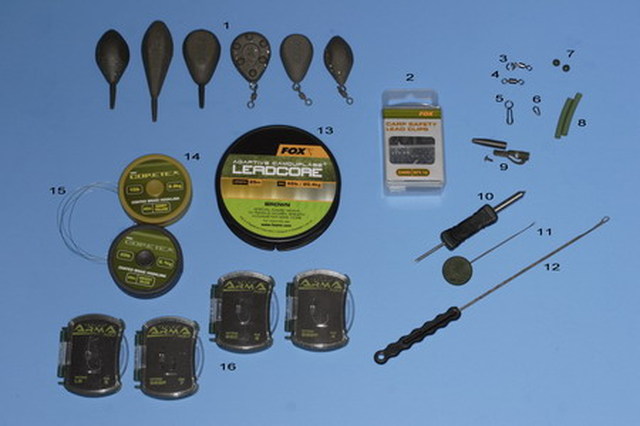
The items are:
- Selection of leads, ranging from inline to flat pear, to tri pear to a grippa lead
- Lead clips, always get them from a reputable manufacturer rather than shop own brands.
- Ring swivels
- Swivel
- Running lead clip
- Tear drop link
- Beads
- Rubber tubing
- Lead clip
- Tension tool, knot picker
- Lead core splicing needle
- Latch gate baiting needle
- Leadcore
- Hybrid braid
- Standard 10lbs monofilament line
- Selection of hooks in various sizes
How to tie a knotless knot hair rig
Without a doubt hair rigs have transformed the fishing scene. The basic hair rig is an easy rig to tie and offers secure bait holding properties and superb hooking capability.
Without a doubt hair rigs have transformed the fishing scene. The basic hair rig is an easy rig to tie and offers secure bait holding properties and superb hooking capability.
Step 1
Take your chosen length of hooklink, this can be anything from around 4inches to 10inches+
If using a coated braid strip back a section of the coating, this will normally be around 3-4inches. Then with this stripped section tie a small simple over hand loop.
Step 2
Thread your chosen bait onto your hooklink using a baiting needle, then finish it off with a bait stop through your loop.
Step 3
Now thread your hook onto your hooklink and measure how long you want your hair to be. (the hair is the section between the hook and bait). The hair can be as look or as short as you like to a certain extent, but you dont want the hair to be any shorter than the length of the hook.
Step 4
Now loop your tag end around the shank of your hook around 5-8 times whilse holding the length of your hair in place.
Step 5
Now push the tag end of your hooklink through the back of the hook, and slowly pull tight.
Step 6
Your finished rig!
At this stage you may choose to add a small piece of shrink tubing over the eye of your hook.
All shapes and sizes of hook baits can be used on this rig, and although its one of the most basic rigs out there, its one of the most effective!
Take your chosen length of hooklink, this can be anything from around 4inches to 10inches+
If using a coated braid strip back a section of the coating, this will normally be around 3-4inches. Then with this stripped section tie a small simple over hand loop.
Step 2
Thread your chosen bait onto your hooklink using a baiting needle, then finish it off with a bait stop through your loop.
Step 3
Now thread your hook onto your hooklink and measure how long you want your hair to be. (the hair is the section between the hook and bait). The hair can be as look or as short as you like to a certain extent, but you dont want the hair to be any shorter than the length of the hook.
Step 4
Now loop your tag end around the shank of your hook around 5-8 times whilse holding the length of your hair in place.
Step 5
Now push the tag end of your hooklink through the back of the hook, and slowly pull tight.
Step 6
Your finished rig!
At this stage you may choose to add a small piece of shrink tubing over the eye of your hook.
All shapes and sizes of hook baits can be used on this rig, and although its one of the most basic rigs out there, its one of the most effective!
How to setup an Inline safety rig.
This initial set-up is one of my favourites and one of the safest; many different hook baits can be presented in a variety of ways using this method.
The safety aspect of the rig has two functions, firstly should the weight become snagged during the playing of the fish, the lead will pull free from the clip and leave the rig intact, ensuring the angler does not loose the fish. And secondly, should the line break as mentioned before, the lead will either pull free releasing the fish or the swivel will pull from the safety clip housing, again releasing the fish.
Step 1
Simply tie your leader or line onto your size 8 standard swivel. In this example we have used leadcore with a half blood knot....
Step 2
Thread your lead clip and then tail rubber onto your leader...
Step 3
Firmly push the swivel inside the lead clip. It is imporant that you push the swivel far enough so that it is tight in place.
Step 4
Now thread your chosen lead onto your lead clip. Then while lubricating with saliva push the tail rubber over your lead clip! Do not push the tail rubber over too much of the lead clip! Just covering the notch on Swims lead clips is perfect and will allow your lead to drop off when necessary.
Lead clips allow you to change your lead in seconds so you can adapt to different situations when needed.
Tip
At this stage you may wish to add a Quick Link or similar product to your swivel, this will allow you to quickly change hooklinks. This can extremely useful when using PVA bags!
How to setup a helicopter rig.
The Helicopter rig got its name from the way the hook bait revolves around the rig tubing, between the two soft rubber beads. This was one of the early rigs used by specimen anglers, and is a good rig to use in silt or weed covered swims.
The Helicopter rig got its name from the way the hook bait revolves around the rig tubing, between the two soft rubber beads. This was one of the early rigs used by specimen anglers, and is a good rig to use in silt or weed covered swims.
Step 1
Thread on a size 8 or 12 Link-Swivel onto your Leadcore followed by around 5mm of silicone tubing and a 6mm rubber bead....
Step 2
On the opposite end of your leadcore thread on a rig sleeve. You will then need to remove any swivels from the lead, strip a short lection of lead from the leadcore and tie the lead on, many knots can be used here but in this example with have used a half blood knot. The rig sleeve should then be pushed back down over the lead loop to create a clean and flush finish...
Step 3
Slide the silicone tubing down the leadcore and seat the bead over the top of it. You may wish to use a Quick link in conjunction with the lead to allow you to change leads for different scenarios in seconds!
Tip: When fishing in deep silt slide your bead further up the leadcore to eliminate the chance of your hook link being buried.
Step 4
In the event of a breakage you must make sure your bead and swivel can slide free of your leader when put under pressure!
Thread on a size 8 or 12 Link-Swivel onto your Leadcore followed by around 5mm of silicone tubing and a 6mm rubber bead....
Step 2
On the opposite end of your leadcore thread on a rig sleeve. You will then need to remove any swivels from the lead, strip a short lection of lead from the leadcore and tie the lead on, many knots can be used here but in this example with have used a half blood knot. The rig sleeve should then be pushed back down over the lead loop to create a clean and flush finish...
Step 3
Slide the silicone tubing down the leadcore and seat the bead over the top of it. You may wish to use a Quick link in conjunction with the lead to allow you to change leads for different scenarios in seconds!
Tip: When fishing in deep silt slide your bead further up the leadcore to eliminate the chance of your hook link being buried.
Step 4
In the event of a breakage you must make sure your bead and swivel can slide free of your leader when put under pressure!
